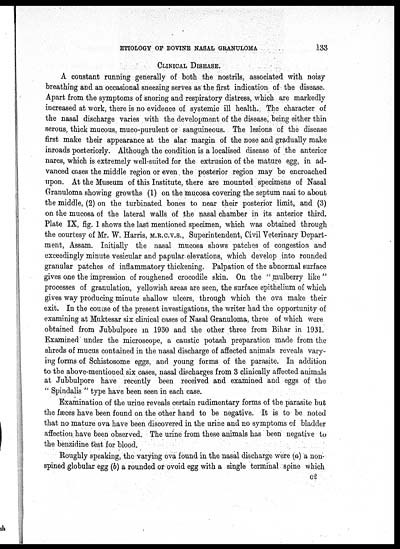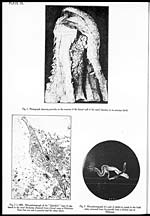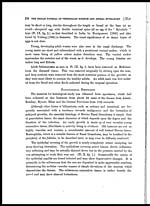Medicine - Veterinary > Veterinary colleges and laboratories > Indian journal of veterinary science and animal husbandry > Volume 2, 1932 > Original articles > Etiology of bovine nasal granuloma
(153) Page 133
Download files
Individual page:
Thumbnail gallery: Grid view | List view

ETIOLOGY OF BOVINE NASAL GRANULOMA 133
CLINICAL DISEASE.
A constant running generally of both the nostrils, associated with noisy-
breathing and an occasional sneezing serves as the first indication of the disease.
Apart from the symptoms of snoring and respiratory distress, which are markedly
increased at work, there is no evidence of systemic ill health. The character of
the nasal discharge varies with the development of the disease, being either thin
serous, thick mucous, muco-purulent or sanguineous. The lesions of the disease
first make their appearance at the alar margin of the nose and gradually make
inroads posteriorly. Although the condition is a localised disease of the anterior
nares, which is extremely well-suited for the extrusion of the mature egg, in ad-
vanced cases the middle region or even the posterior region may be encroached
upon. At the Museum of this Institute, there are mounted specimens of Nasal
Granuloma showing growths (1) on the mucosa covering the septum nasi to about
the middle, (2) on the turbinated bones to near their posterior limit, and (3)
on the mucosa of the lateral walls of the nasal chamber in its anterior third.
Plate IX, fig. 1 shows the last mentioned specimen, which was obtained through
the courtesy of Mr. W. Harris, M.R.C.V.S., Superintendent, Civil Veterinary Depart-
ment, Assam. Initially the nasal mucosa shows patches of congestion and
exceedingly minute vesicular and papular elevations, which develop into rounded
granular patches of inflammatory thickening. Palpation of the abnormal surface
gives one the impression of roughened crocodile skin. On the " mulberry like '"
processes of granulation, yellowish areas are seen, the surface epithelium of which
gives way producing minute shallow ulcers, through which the ova make their
exit. In the course of the present investigations, the writer had the opportunity of
examining at Muktesar six clinical cases of Nasal Granuloma, three of which were
obtained from Jubbulpore in 1930 and the other three from Bihar in 1931.
Examined under the microscope, a caustic potash preparation made from the
shreds of mucus contained in the nasal discharge of affected animals reveals vary-
ing forms of Schistosome eggs, and young forms of the parasite. In addition
to the above-mentioned six cases, nasal discharges from 3 clinically affected animals
at Jubbulpore have recently been received and examined and eggs of the
" Spindalis " type have been seen in each case.
Examination of the urine reveals certain rudimentary forms of the parasite but
the fæces have been found on the other hand to be negative. It is to be noted
that no mature ova have been discovered in the urine and no symptoms of bladder
affection have been observed. The urine from these animals has been negative to
the benzidine test for blood.
Roughly speaking, the varying ova found in the nasal discharge were ( a) a non-
spined globular egg ( b) a rounded or ovoid egg with a single terminal spine which
C 2
Set display mode to: Large image | Zoom image | Transcription
Images and transcriptions on this page, including medium image downloads, may be used under the Creative Commons Attribution 4.0 International Licence unless otherwise stated. ![]()
| Permanent URL | https://digital.nls.uk/75227658 |
|---|
| Description | Covers articles from 1932. |
|---|




